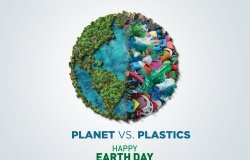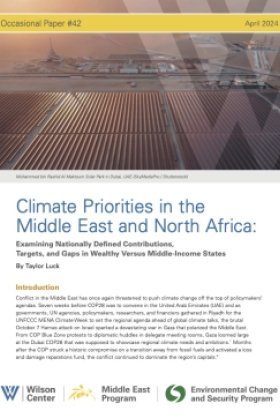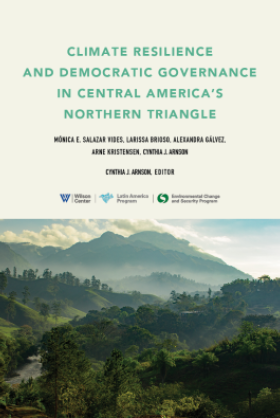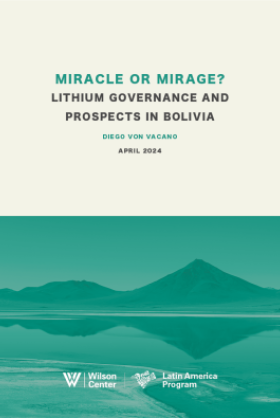Implementation of the Senator Paul Simon Water for the Poor Act of 2005
Signed into law in December 2005, the Senator Paul Simon Water for the Poor Act calls for the United States and 185 other nations to fulfill their joint commitment to one of the Millennium Development Goals (MDG): to halve the percentage of people without access to safe water and sanitation by 2015.
Overview
Signed into law by President George W. Bush in December 2005, the Senator Paul Simon Water for the Poor Act calls for the United States and 185 other nations to fulfill their joint commitment to one of the Millennium Development Goals (MDG): to halve the percentage of people without access to safe water and sanitation by 2015. The act marked the first time an MDG was written into American law. On April 23, 2007, the Wilson Center's Environmental Change and Security Program, along with the U.S. Department of State and the Center for Strategic and International Studies, convened a wide range of stakeholders to collect feedback on the ongoing implementation of the act, and provide a forum to discuss the U.S. Department of State's yearly mandated water and sanitation strategy report to Congress. The event, broken into two sessions, included a panel discussion on the balance of short-term emergency versus long-term development water and sanitation assistance, and a facilitated discussion on ways to improve the effectiveness of U.S. assistance in the water sector.
The Water for the Poor Act has helped shape the way the United States approaches provision of safe water and sanitation in developing countries, said Assistant Secretary of State Claudia McMurray. But she added that the development and implementation of the WFP strategy is still a work in progress, and requires additional support on two fronts: governance and capacity; and private investment. Governance, she said, is a dual concept, including both proper management at the local, national, and regional levels, as well as the development of institutional capacity to manage water across multiple uses. Additionally, she noted the importance of strengthening domestic utility management and regulation, and argued that countries cannot rely on development assistance alone to meet their water and sanitation needs. To this end, she advocated more private investment in local water companies, which could help sustain smaller-scale water projects, and also engage communities as stakeholders.
Transitioning From Emergency to Development Assistance
The transition from short-term emergency aid to long-term development assistance raises many concerns, particularly around issues such as water that are critical in both phases. Relief and development agencies must work together to make the transition smooth, the speakers agreed. Additionally, Peter Lochery, director of the water team at CARE, emphasized the need for relief organizations and aid agencies to have clearly defined roles, as well as separate bank accounts: Emergency situations should draw on money specifically for disaster relief, rather than diverting funds from development, for example. He added that keeping development aid for development purposes can also pay off during disasters: "Building up management skills pays dividends in times of emergency."
According to Liz McBride of the International Rescue Committee, disaster relief used to include a development component, but today relief workers spend considerably less time on the ground. As a result, development organizations are challenged to be many things to many people: multi-lateral, multi-sectoral, community-driven, and large-scale. And to be sustainable, development goals are expected to be coupled with governance strategy. She proposed greater effort on the grassroots level to make communities more stable and resilient during periods of emergency.
Ian Moise, technical adviser on water, sanitation, and hygiene at the U.S. Agency for International Development, noted the need to overcome the "relief mentality" often applied to humanitarian projects, particularly water provision. Short-term water provision involves getting water into dry hands, but the means of doing so are often inefficient in the long run. Long-term thinking on water is more complex, as it requires a sanitation component and foresight. Choices—infrastructural, systematic, and technological—must be made in order to ensure sustainability of long-term water and sanitation, and management principles need to be devised and tailored to specific settings. He also noted that sustainability may result from creative problem solving: "I encourage…innovative solutions—maybe privatization, or women's groups and use groups taking over the management of some of these structures."
Chris McGahey, of the Global Environment and Technology Foundation, pointed out that development approaches have often failed to look to private-sector approaches, even in situations like water where corporate strategies might be more efficient. But there are signs of a new trend in leadership, involvement, and funding by private sector—at all points along the emergency-development continuum. Some successful examples of the "corporate-social agenda" were noted, including the alignment of corporate and social objectives as a way of building long-term competitiveness.
Developing a U.S. Water Strategy
In the hopes of informing the next WFP report to Congress, the second session attempted to find answers to the following questions:
- Do private enterprises and NGOs provide input in prioritizing where the work is done?
- How can government agencies work more effectively with NGOs and the private sector?
- What important but unanticipated issues are on the horizon for the United States?
U.S. water strategy must include explicit methodology, timetables, goals, and metrics if there is to be any hope of scaling up specific projects. Without these critical pieces, it will be impossible to tell whether a project has indeed been successful. And if it has not been successful, these same pieces will be needed to identify stumbling blocks. For example, did a project have enough financial capital but fail because it lacked human capital? This point was reinforced by Judah Ariel, the senior legislative assistant in the Office of Congressman Earl Blumenauer, who said these tools and markers are crucial to ensuring that what is laid out in legislation is achieved on the ground.
Sally Cowal, a veteran of the AIDS movement and a leader in working with household point of use water products, said that adequate resources are critical to U.S. water strategy. Interestingly, the private sector has shown unprecedented involvement in water, which may generate political will and spur Congress to increase funding for water. Cowal also noted that, similar to other successful development projects, water strategy needs to include a gender component, and engage women at the community level.
Gordon Binder, a senior fellow at the World Wildlife Fund, said that WFP is an opportunity to rethink develop assistance and use it as a tool for conflict prevention, as well as greater development strategy. Like Ariel, Binder urged greater monitoring and evaluation of water projects, as well as investment in human infrastructure to make sure that those projects on the ground are running efficiently. These micro-level approaches will help on the ground, but Binder noted that water is currently an issue without a home: "Water has no voice in the government. It needs a champion." Without the creation of a higher-level position—whether an Ambassador for water or a top-level adviser on water in USAID or the State Department—it will be "hard to claim priority [for water]," he said.
Drafted by Christine A. Craddock and Alison Williams.
Speakers
Judah Ariel
Gordon Binder
Sally Cowal
Peter Lochery
Liz McBride
Chris McGahey
Ian Moise
Claudia McMurray
Daniel A. Reifsnyder
Hosted By

Environmental Change and Security Program
The Environmental Change and Security Program (ECSP) explores the connections between environmental change, health, and population dynamics and their links to conflict, human insecurity, and foreign policy. Read more
Thank you for your interest in this event. Please send any feedback or questions to our Events staff.










